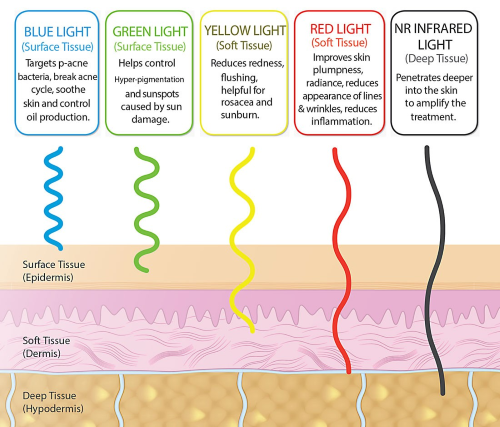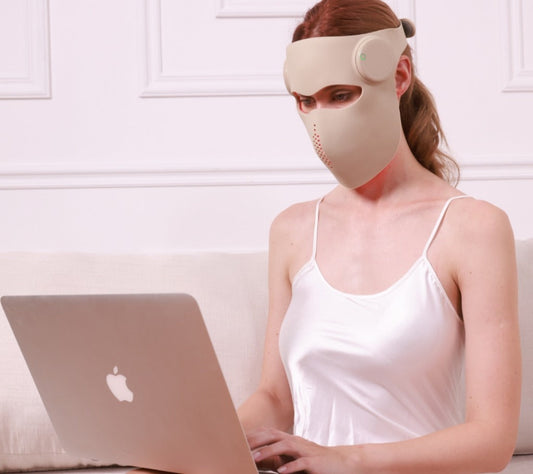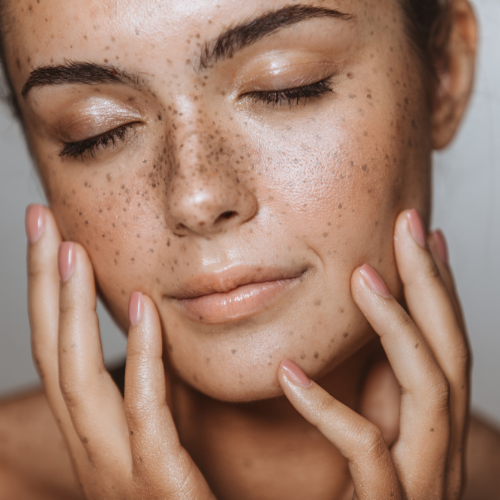
Light Therapy - Colour and Wavelength insight
Share
There are several types of light therapy, each using different wavelengths of light to target specific conditions. The most commonly used wavelength for red light therapy is 660nm, which is within this range. This wavelength has been shown to penetrate deep into the skin and tissues, promoting blood flow and pain relief. Other effective wavelengths for red light therapy include 630nm and 850nm
The types of light therapy include:
Red Light Therapy (630–700nm) Red light therapy uses wavelengths in the visible red spectrum to penetrate the outer layers of the skin and underlying tissues. This therapy is highly effective for skin rejuvenation, pain relief, and wound healing. Red light is often regarded as the ultimate anti-aging tool. Studies have shown its ability to reduce the appearance of fine lines and wrinkles by stimulating the production of collagen and elastin—essential proteins for maintaining firm, healthy, and youthful skin.
Additionally, red light therapy enhances overall facial texture, minimizes scars, and supports a smoother complexion. It’s particularly beneficial for individuals looking to reverse early signs of aging or repair damaged skin. Due to its versatility and effectiveness, red light therapy is the most widely chosen wavelength for skincare, frequently used alongside Near-Infrared (NIR) for deeper tissue benefits.
Deep Red Light Therapy (665–680nm) Deep red light operates at wavelengths that reach slightly deeper than standard red light, making it exceptionally potent for advanced skin repair and rejuvenation. Its enhanced penetration supports improved blood circulation, aiding in faster cellular renewal and recovery. This wavelength excels in tackling stubborn skin concerns such as deeper wrinkles or uneven tone, while also accelerating the healing process for minor injuries and inflammation.
Deep red light is preferred for users seeking more intensive outcomes in areas with visible signs of aging or persistent skin damage. It pairs beautifully with Near-Infrared (NIR) light for a synergistic effect on both surface and deeper layers of the skin.
Near-Infrared (NIR) Light Therapy (700–1000nm) Near-infrared light is invisible to the naked eye and can penetrate even deeper than red and deep red wavelengths. This light therapy is beneficial for addressing issues beneath the skin's surface, including pain relief, inflammation reduction, and enhanced muscle recovery.
Clinically, NIR has been shown to improve tissue repair by increasing oxygenation and blood flow to targeted areas. It also works in harmony with red and deep red light, enhancing collagen production and cellular function in deeper layers for comprehensive skin rejuvenation. Its versatility extends to addressing aches, improving skin elasticity, and promoting overall skin health and vitality.
Long Wave Infrared Light Therapy (1064nm) Long wave infrared light, also invisible to the eye, operates at one of the deepest penetrating wavelengths available in photothermal therapy. This wavelength is especially effective for targeting deeper wrinkles, nasolabial folds, and fine lines around sensitive areas such as the eyes and mouth. It stimulates collagen production deep within the dermis, leading to plumper, firmer, and rejuvenated skin.
Additionally, 1064nm light is excellent for reducing dark circles and addressing long-term skin concerns like loss of elasticity. Its ability to activate deeper layers of collagen makes it an exclusive choice for users seeking advanced anti-aging benefits. The heat effect generated by this wavelength also helps promote skin tightening and enhances the skin's natural repair processes.
Blue Light Therapy: Uses blue wavelengths (400-495nm) to target the uppermost layer of the skin. It is commonly used to treat acne by killing bacteria and reducing oil production. It's also been shown to help with those who have psoriasis and reduce damage caused by the sun. This is the preferred choice of those contending with persistent Acne and finding ingredient-oriented remedies challenging.
Purple Light Therapy: This is a combination of red and blue and shares the same benefits accordingly
Green Light Therapy: Uses green wavelengths (495-570nm) to target pigmentation issues and promote even skin tone. It can also help reduce redness and irritation. Is for reducing dark spots as well as balancing out skin levels for those with oily skin. Studies have also shown it aids with hyperpigmentation and reducing inflammation. However, the it's most commonly known for reducing bags under eyes by users
Yellow Light Therapy: Uses yellow wavelengths (570-590nm) to improve skin hydration, reduce redness, and enhance overall skin radiance. It is often used for sensitive or delicate skin. Is used for calming inflammation and reducing redness. It also boosts lymphatic flow which helps remove toxins and increases skin hydration/circulation.
Orange/Amber Light Therapy: Uses wavelengths (600-620nm) to improve skin hydration and colourisation. Is used for firming up the skin, reducing dullness and dark spots. Users will often report their skin "glowing" when used regularly and is one of the favorites used leading up to a special occasion.
Cyan Light Therapy: Uses cyan wavelengths (490nm) and is applied for alleviating swollen capillaries and inflammation, with studies indicating its efficacy in addressing mild acne.
White Light Therapy: Encompasses the full spectrum of visable light (400-700nm) and used for accelerating skin metabolism and firming up the skin. It also has many of the same benefits of red such as reducing fine lines, reducing wrinkles and inflammation
UV Light Therapy: Uses ultraviolet light (UVB and UVA) to treat skin conditions such as psoriasis and eczema. It is also used to treat newborn jaundice



